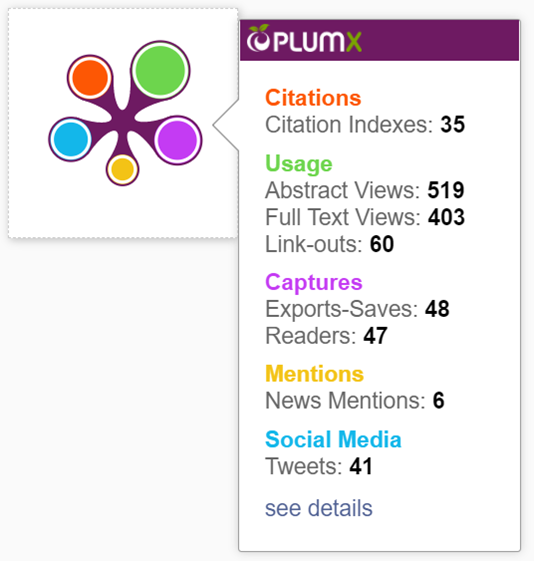The term altmetrics refers to metrics and qualitative data that are complementary to traditional, citation-based metrics. They can explain both the volume and nature of attention that research receives online. Altmetrics directly measure the attention of a publication by how many times it has been viewed, downloaded, liked, shared or mentioned from a variety of online tools and social media.
Altmetrics can be used to demonstrate the dissemination of your research outside of academia and traditional discipline boundaries; and evidence of community, national, and/or international engagement.
They can also indicate potential impact, for example mentions in policy documents and commentary from experts and practitioners. They provide insights into who is saying what about your research, and where in the world it is being cited, reused, read etc.
Considerations
Altmetrics are a complement to, not a replacement for traditional citation-based metrics.
The overall attention received by a research output does not indicate the quality of that output. Make sure you look at the qualitative data behind the metrics, who is talking about your research and what they are saying.
Sources for Alternative Metrics
Altmetric Explorer
Altmetric Explorer is used to discover the volume and nature of online attention to your research outputs. Track the global engagement of your work via Twitter, Facebook, Wikipedia mentions, online opinion pieces (e.g. The Conversation), news stories, citations in policy documents, downloads to Mendeley libraries and more.
More Information About Altmetric Explorer
Western Sydney University provides access to Altmetric Explorer to track and analyse the online attention received by scholarly outputs. Altmetric Explorer gathers data from several sources.
The Altmetric Attention Score (pictured inside the donut below) represents a weighted count of the amount of attention that output has received. A weighted count reflects both the number of posts and the quality of the post's source. For example, a news story is likely to have more reach than a Tweet or LinkedIn post.
An example:

Source: Smith, C. A., Armour, M., & Dahlen, H. G. (2017). Acupuncture or acupressure for induction of labour. Cochrane Database of Systematic Reviews (10). https://doi.org/10.1002/14651858.CD002962.pub4
Ensure you always include the persistent identifier (such as DOI or ISBN) when posting about your work online so that Altmetric Explorer can track and record this activity. You can access Altmetric Explorer using the link below and create a free account using your Western email address to start tracking your scholarly outputs.
Further Resources
Scopus PlumX
PlumX Metrics is a tracking tool available in Scopus. It provides both traditional citations and altmetrics in one overall view. PlumX gathers metrics for scholarly outputs and categorises them into five categories to enable analysis by comparing metrics that are "like for like":
- Citations – traditional citations as well as patent, clinical and policy citations.
- Usage – clicks, downloads, views, library holdings, video plays.
- Captures – bookmarks, favourites, readers, watchers, exports/saves.
- Mentions – blog posts, comments, reviews, news media, Wikipedia references.
- Social Media – shares, likes, comments, tweets.
Similar to the Altmetric Explorer donut, the Plum Print (pictured below) visualises the relative number of metrics in each category. Each colour of the print represents a different category of attention.
An example:

Source: Power, E. R. (2017). Renting with pets: A pathway to housing insecurity? Housing Studies, 32(3), 336-360. https://doi.org/10.1080/02673037.2016.1210095
Access PlumX Metrics via Scopus. The Plum Print displays on the 'Document details' pages of articles/scholarly outputs. Click 'see details' for specific mentions.